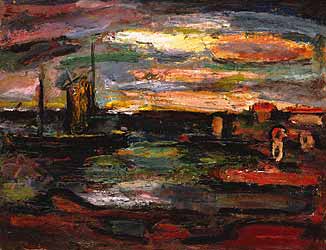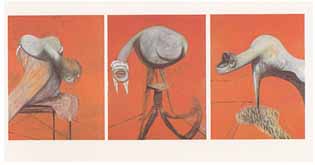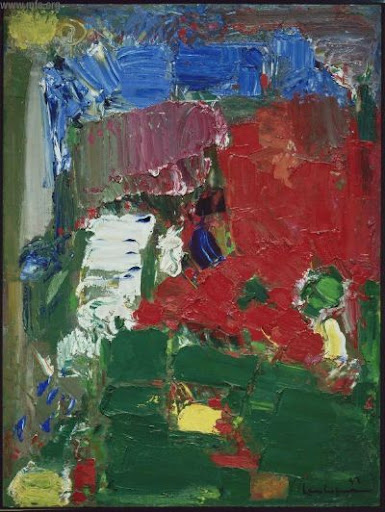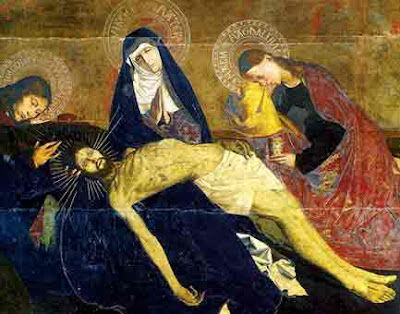
In 'Art for Contemplation' I am thinking of active reflection using a medium (words, colors, shapes, film, clay, etc) giving a high level of attention while releasing control of the outcome of the reflection. In the paradigm of Friere's, Pedagogy of the Oppressed, this would be a way of reflecting on our action or 'Praxis'.
Rouault landscape.
Some of Rouaults works like his King David painting were said to have been worked on over a period of 50 years. The textures and colors, scrapes and pulls of the paint are the material of his contemplation of life as he experienced it. One just needs to stand in front of His paintings to see layer after layer built up until some portions of the painting will rise above the surface of the canvas an inch or so.
Francis Bacon 'Crucifixion'
Here is a Francis Bacon trip tic I saw in England. It is a horrific painting. One only needs to remember that he was contemplating the state of humanity post World War 2. Maybe it is horrific but accurate as well and therefore helpful.
This is a shot from the Andrei Tarkovsky film 'The Sacrifice'
Andrei Tarkovsky the Russian film maker used slow choreographed takes so that he could cut the film as rarely as possible. In doing this he reflects the time of human experience. There is a sense of space and breath. Watching his films is like crawling into the skin of a monk for a couple hours and seeing the world through the eyes of a contemplative. Tarkovsky teaches us contemplation as he offers us his sense of time and composition in the film.
Hans Hoffman paintings demonstrate an incredible beauty, specifically diversity in unity. In any image abstract or narrative which brings together any diversity into unity is a symbol of the Holy Trinity. It gives you a visual 'proof' of the real possibility of unity in diversity. Anything beautiful in this sense is an icon of the Holy Trinity. More than many other abstract expressionist painters Hoffman has a sense of the spiritual transcendent radiating from his work.
In this pieta the visual curving form of the body becomes a theological aesthetic way to deal with grace. Visual grace participates in the truth of redemptive theological experiential grace. The form of the art is created to contemplate and aid in the contemplation of the spiritual realities depicted.
charcoal drawings by Sarah Lanse
Similarly Sarah has used here the process of charcoal drawing to contemplate her experiences of the suffering of the women she is working with. There is a real black and white, death and life severity to the drawings. Calcutta is far from a black and white place visually but certainly life and death are most present to the senses than in many other more insulated places in the world.
Micheal Nye is a great contemporary photographer who incorporates audio stories of persons being photographed. He has a show on living with mental illness with beautiful insightful photos of people he collaborated with and their accounts of how they experience life. It is startlingly personal and intimate. His process of photographing and audio interviewing is a great way of being attentive to another person, humanizing then, and discovering their unique story. When we spend time contemplating the individual lives of the poor in dignifying ways we find empathy and common humanity with the poor.
Art for contemplation is also a means of gaining insight, understanding and building empathy.
Here are some ideas to consider...
- Journaling- high attention to what happened (or what is happening) without controlling the outcome of the reflection.
- Drawing- simply sitting down and drawing from life can be a great way to hear God speaking through the tree, river, or the person drawn.
- Open ended Drawing, painting, writing. (ex. Creating a set of characters with personalities etc, and then letting their personalities decides the outcome of the story)
- writing poetry- Josh Fowler some public, some private reflection.
- Video editing- bringing together themes in audio and video material. Reflecting on the content of the pieces and finding the connections between the parts. The stuggle with video or other digital media seems to be that the process can be so quick there is no space for contemplation. It takes discipline and patience to give the though and attention to create pieces which are going to also draw others into contemplation.
In 'Art for Contemplation' we are ‘gathering’ together the theological truths as they express themselves in creation, in all its processes, shapes, and colors. Contemplation is a focused way that faith and experience are integrated.






1 comment:
Thank you. Much to meditate on. Much love bro.
Post a Comment